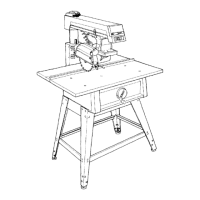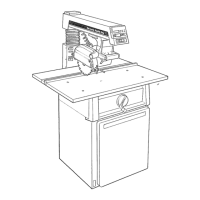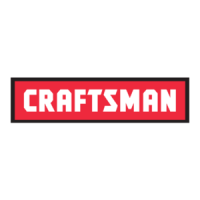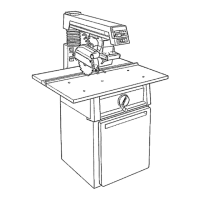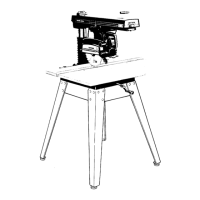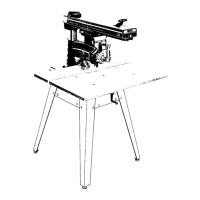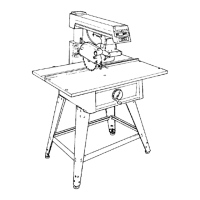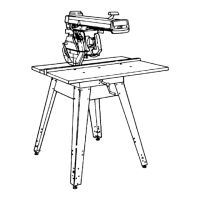provideadditionalguardingfromcontactwiththe
frontof theblade.
--To preventthe cutting tool from grabbingthe
tableor workpieceandbeingpropelledtoward
you,neverlowerarevolvingcuttingtoolintothe
tableor aworkpiecewithoutfirst lockingthe rip
lockhandleandclampingtheworkpieceinplace.
Releasethe handle only after having firmly
graspedthecarriagehandle.
-- Toavoidbladecontactorinjuryfromathrowncut
off piece,neverusea lengthstoponthecut off
endoredgeof theworkpiece.Neverhangontoor
touchthecut offpieceoftheworkpiecewhilethe
poweris"ON"and/orthesawbladeisrotating.To
preventpinchingthatcouldcausethepiecetobe
thrown,thecutoffpiecemustneverbeconfined,
pushed,or grabbedwhilethebladeisspinning.
INSPECT YOUR WORKPIECE
--To avoid injury from thrown objects, slips or
jamming of the blade, make sure the workpiece
will fit the supports (fence, table, fixtures or jigs)
so it will not twist, rock or otherwise bind on the
cutting tool. Make sure there is no sawdust or
other foreign material between the workpiece and
its support.
WHILE DOING A CROSSCUT TYPE CUT
--Always start with the carriage in the full rear
position behind the fence before turning the sew
OR.
-- Never push the carriage and blade backwards
into the work to do a crosscutting type operation.
The cutting tool can throw the work over the
fence, striking someone or causing you to fall into
the blade.
--Always return the carriage to the full rearward
position behind the fence at the completion of
each crosscut type operation. Never remove your
hand from the yoke handle unless the carriage is
in this position. Otherwise, the cutting tool may
climb up on.the workpiece and be propelled
toward you.
BEFORE USING ACCESSORIES
-- To avoid injury from unanticipated hazards, use
only recommended accessories as listed on page
41.
-- The use of grinding wheels, abrasive or cut off
wheels, or wire wheels, can be dangerous and are
not recommended. Such devices can break ex-
plosively and throw shrapnel, causing severe
injury.
-- The sawblade, dado, or other cutting tool must be
removed from the saw arbor before using the
accessory shaft. Never operate the saw with
cutting tools (including sanding accessories or
buffing) installed on both ends of the saw arbor to
avoid being pulled into moving parts by hair,
threads, clothing, etc. Make sure the unused
arbor is always covered by a guard, the arm, orthe
screw cap.
-- Using a drill chuck. To avoid injury from sudden
bending or breaking of a drill bit, do not install or
use twist drills longer than 7" in length or extend-
ing more than 6" beyond the chuck jaws. Do not
install or use any reduced shank drill except the
spade type (1" diameter or smaller). Use for
drilling wood or plastic only - bit speed cannot be
properly adjusted for other materials. Do not use
twist drills larger than 1/2" in diameter.
glossary of terms for woodworking
Anti-Kickback Pawls (AKB)
Device which, when properly adjusted, is designed
to stop the workpiece from being kicked back at the
operator during ripping operations. See illustrations
on pages 20 & 24.
Arbor
The shaft on which a cutting tool is mounted.
Crosscut
A cutting or shaping operation made across the
width of the workpiece. See illustrations on pages
25-26.
Dado
A non-through cut which produces a square sided
notch or trough in the workpiece.
Featherboard
A device which can assist in guiding workpieces
during rip type operations.
Freehand
Performing a cut without the use of fence (guide),
hold down or other proper device to prevent the
workpiece from twisting during the cutting opera-
tion. Twisting of the workpiece can cause it to be
thrown or kicked back by a radial saw.
Gum
A sticky, sap based residue from wood products.
Heel
Misalignment of the blade. See page 18.
In-Rip
Positioning the blade parallel to the fence with the
motor toward the front of the saw. See illustration on
page 29.
Kerf
The amount of material removed by the blade in a
through cut or the slot produced by the blade in a
non-through or partial cut.
Kickback
An uncontrolled grabbing and throwing of the work-
piece back toward the operator during a rip type
operation.
Leading End
The end of the workpiece which, during a rip type
operation, is pushed into the cutting tool first.
Molding
A non-through cut which produces a special shape
in the workpiece used for joining or decoration.
6
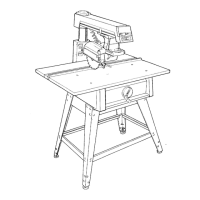
